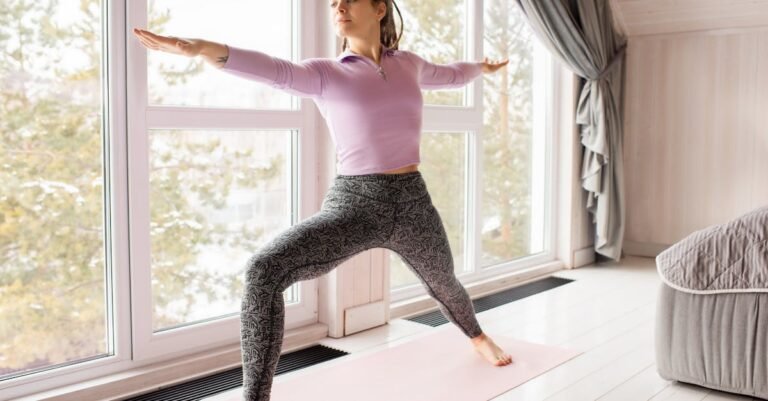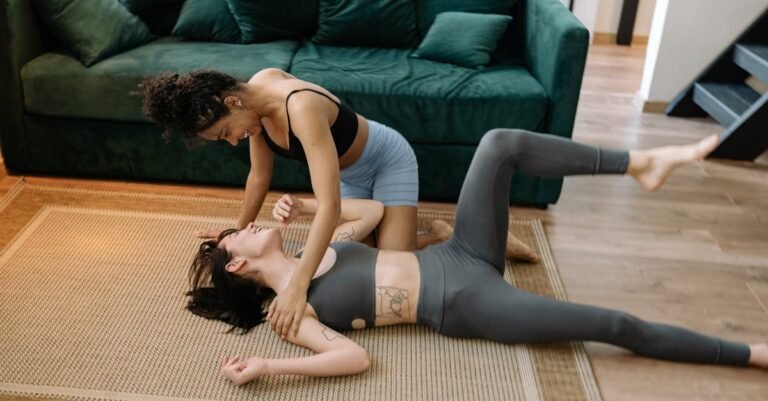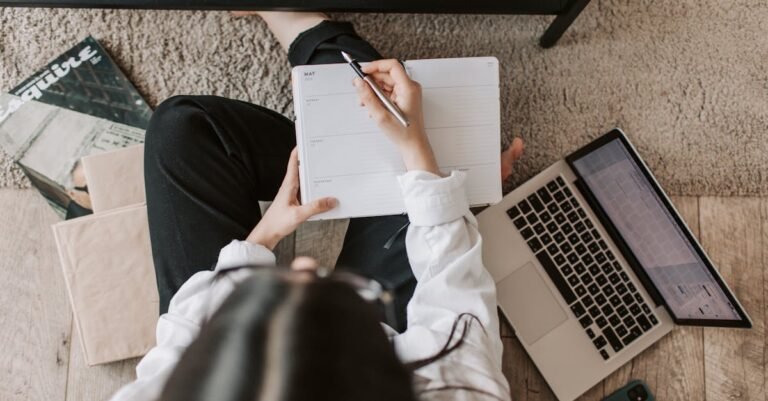Getting older doesn’t mean you have to slow down completely! But maybe your joints are starting to feel a bit creaky, or the idea of hitting a busy gym just doesn’t sound appealing anymore. If you’re nodding along, you’re in the right place. Staying active is super important for feeling good, both physically and mentally, but finding exercises that are gentle on your body can sometimes feel tricky. This article is all about low-impact home workouts – simple, effective ways to move your body without putting extra stress on your knees, hips, or back. We’ll chat about why these exercises are awesome, give you some easy ideas you can try today, and talk about how to stay safe while you do them. By the end, you’ll have some great tools to keep moving comfortably right in your own home.
Why Go Low-Impact? It’s Kinder to Your Body
So, what does “low-impact” even mean? Think of it like this: it’s exercise where you usually keep at least one foot on the ground. Unlike high-impact stuff like running or jumping, which can jar your joints, low-impact moves are much smoother and gentler. Why does this matter, especially as we get older? Well, our joints have been working hard for years! Things like cartilage, the cushion between bones, can wear down. Low-impact exercise helps protect those precious joints – your knees, hips, ankles, and back will thank you!
It means you can get the benefits of moving – like better heart health, more energy, and stronger muscles – without the aches and pains that might come from more intense activities. Imagine trying to do jumping jacks like you used to, and your knees start complaining immediately. Low-impact exercise is like giving those joints a supportive hug instead of a jolt. It’s all about working *with* your body, not against it, helping you stay mobile and reducing the risk of getting hurt.
Getting Started: Setting Up Your Home Workout Space
You don’t need a fancy home gym to get started. Seriously! Your living room, bedroom, or even a wide hallway can work perfectly. The main thing is having a little clear space where you won’t bump into furniture or trip over things. Give yourself enough room to move your arms and legs freely.
What should you have handy?
- Comfy Clothes: Wear something loose-fitting that lets you move easily.
- Supportive Shoes: Even though you’re inside, good shoes can provide stability and cushioning. Skip the floppy slippers!
- Water Bottle: Keep water nearby to stay hydrated.
- A Sturdy Chair: This is super useful! You can use it for support during balance exercises or for seated workouts. Make sure it’s stable and won’t slide around.
Before you start, do a quick safety check. Move any throw rugs that could slip, tuck away cords, and make sure the area is well-lit. Simplicity is key here – you just need a safe, comfortable spot to move.
Gentle Cardio Moves You Can Do Right Now
Getting your heart pumping a bit is fantastic for energy levels and overall health. But you don’t need to run a marathon! Low-impact cardio gently raises your heart rate without pounding your joints.
Here are a few easy ones to try:
- Marching in Place: Stand tall and lift your knees one at a time, like you’re marching. Start slow, and if you feel good, lift your knees a bit higher or swing your arms. You can even do this while holding onto a chair for balance.
- Step-Touches: Stand with feet together, then step one foot out to the side and tap your other foot next to it. Step back to the center and repeat on the other side. Keep it flowing side to side.
- Seated Marching: If standing feels like too much today, sit tall in your chair and march your feet up and down. You can add arm swings too!
- Arm Circles: Stand or sit tall and make big (or small!) circles with your arms, first forward, then backward. This gets the blood flowing in your upper body.
Think about marching in place during a TV commercial break – it’s that simple! Just a few minutes of these gentle moves can make a real difference to your heart and energy.
Building Strength Without the Strain
When we talk about strength, it’s not just about looking buff. It’s about having the muscle power to do everyday things easily – like carrying groceries, opening jars, getting out of a chair, or playing with grandkids. And guess what? You can build strength without lifting super heavy weights or doing strenuous exercises.
Try these gentle strength builders:
- Chair Squats: Stand in front of a sturdy chair, feet hip-width apart. Slowly lower your bottom towards the chair as if you’re going to sit down, keeping your chest up. Only go as low as feels comfortable, maybe just tapping the chair lightly or stopping before you touch it. Then, push through your heels to stand back up. Use the chair arms for support if needed.
- Wall Push-Ups: Stand facing a wall, about arm’s length away. Place your palms flat on the wall, slightly wider than your shoulders. Keeping your body straight, bend your elbows and lean towards the wall. Push back to the starting position. This is much easier on your wrists and shoulders than floor push-ups.
- Bicep Curls with Light Objects: Sit or stand tall. Hold a soup can or small water bottle in each hand, palms facing forward. Slowly bend your elbows and bring the weights up towards your shoulders. Slowly lower them back down. No weights? Just making a fist and tensing your bicep works too!
- Seated Leg Lifts: Sit tall in your chair. Slowly lift one leg straight out in front of you, keeping your knee straight but not locked. Hold for a second, then slowly lower it. Repeat with the other leg.
The key is slow, controlled movements. Focus on feeling the muscles work, not on doing lots of repetitions quickly.
Flexibility and Balance: Your Secret Weapons
Think about reaching for that jar on the top shelf or bending down to tie your shoes – that requires flexibility, the ability of your joints to move through their full range. And what about walking across a slightly uneven lawn or catching yourself if you stumble? That’s where balance comes in. Both are super important for staying independent and preventing falls as we age.
Simple ways to work on them:
Flexibility Moves (Gentle Stretches):
- Neck Tilts: Slowly tilt your head towards one shoulder, feeling a gentle stretch along the side of your neck. Hold briefly, return to center, and repeat on the other side. Then, gently lower your chin towards your chest.
- Shoulder Rolls: Roll your shoulders up towards your ears, then back and down. Repeat several times, then try rolling them forward.
- Ankle Circles: Sit in a chair and lift one foot slightly off the floor. Slowly circle your foot one way, then the other. Repeat with the other foot.
Balance Boosters (Use a Chair or Wall for Support!):
- Stand on One Foot: Hold onto a chair or countertop. Lift one foot slightly off the ground. Try to hold it for a few seconds. Switch feet. As you get steadier, try holding on with just one hand, then maybe just fingertips, eventually aiming to let go briefly.
- Heel-to-Toe Walk: Imagine walking on a tightrope! Stand near a wall or counter for support. Place the heel of one foot directly in front of the toes of the other foot. Take a few steps forward like this, keeping your eyes looking ahead.
These don’t need to take long, but doing them regularly can make everyday movements feel much easier and safer.
Listen to Your Body: The Most Important Rule
Okay, this is probably the *most* important tip: pay attention to how you feel! Your body is smart and will give you signals. If something hurts, stop or change what you’re doing. We’re aiming for feeling good, not pushing through pain. The old saying “no pain, no gain” definitely doesn’t apply to gentle, low-impact exercise.
Start slow, especially if you’re new to exercise or haven’t been active in a while. Maybe just do 5-10 minutes at first. As you feel stronger and more comfortable, you can gradually increase how long you exercise or how many repetitions you do. It’s way better to do a little bit consistently than to overdo it and then have to stop for days.
Also, remember to warm up before you start and cool down afterward. A warm-up could just be a few minutes of slower marching or gentle movements to get your muscles ready. A cool-down involves slowing down gradually and maybe doing some of those nice, gentle stretches we talked about. And, it’s always a good idea to chat with your doctor before starting any new exercise routine, just to make sure it’s safe for you, especially if you have any health conditions.
Making it Stick: Building a Routine
Starting is great, but keeping it going is where the real magic happens! Building a routine doesn’t have to be complicated. Consistency is more important than intensity. Even 10-15 minutes of movement most days is way better than nothing.
How can you make it a habit?
- Schedule It: Treat your exercise time like an important appointment. Put it on your calendar! Maybe it’s first thing in the morning, during a favorite TV show, or before lunch. Find a time that works for *you*.
- Make it Fun: Put on some music you love! Listen to a podcast or an audiobook. If possible, maybe find a friend or family member to exercise with you, even if it’s just marching in place together while chatting on the phone.
- Start Small & Celebrate Wins: Don’t try to do an hour right away. Start with 10 minutes. Did you do it? Awesome! Give yourself a little pat on the back. Notice if you feel a bit more energetic or less stiff – those small improvements are big wins!
- Mix it Up: Don’t feel like you have to do the exact same thing every day. Maybe focus on cardio one day, strength the next, and flexibility/balance on another. Keep it interesting!
Remember, it’s not about being perfect. Some days you might have more energy than others, and that’s totally okay. Just aim to move your body regularly in a way that feels good.
So, there you have it! Staying active as a senior doesn’t have to involve jarring movements or trips to a crowded gym. Low-impact workouts you can do right at home are a fantastic way to keep your body moving gently and effectively. We’ve talked about why being kind to your joints is so important, how easy it is to set up a simple workout space, and explored gentle ways to boost your heart health, build everyday strength, and improve your flexibility and balance. Remember the golden rule: always listen to your body and check with your doctor before starting something new. Building a routine takes time, so start small, make it enjoyable, and celebrate your progress. Keeping active is totally achievable and can make a huge difference in helping you feel great and stay independent for years to come!










